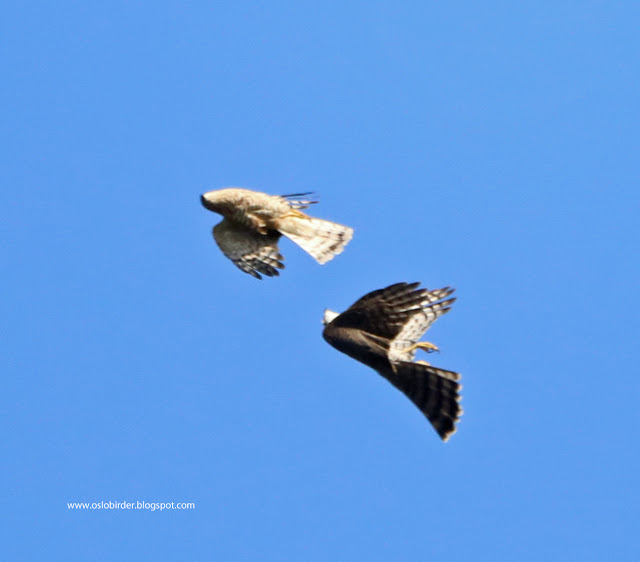Long suffering followers of this blog will know that
there is, or should I now say was, one very common species missing from my
local patch (Maridalen) list. When I was on 199 species I lived in fear that this
species would be the one that brought me to the milestone double tonne and
whenever a visiting birder (none of us regulars were ever so lucky) reports one
(always without a photo) I have been rather scathing. If I had just seen a
report of three House Sparrows from Maridalen I would have again been my usual
doubting self but as it was me who saw them and I have all 3 in the same photo
I guess I have to accept that they do occur in The Dale..!! House Sparrow now
becomes my 206th species in Maridalen following on from Gull-billed
Tern!?! which was my 205th and the 200th if you are
wondering was Kittiwake.
House Sparrow is still a very common species in
suburban and urban Oslo and must occur right up to the southern edge of
Maridalen which abuts the city and Tree Sparrow which is also common in
suburban Oslo occurs in flocks of upto 100 in Maridalen around the farms but
until Monday I had never seen a House for the Trees 😊
It feels very autumnal now with Yellow Wagtails,
Whinchats and Bluethroat regular in Maridalen alongide the odd Red-backed
Shrike and Redstart. Young Sparrowhawks seem to be everywhere and often their
hunting skills on anything they see including Hooded Crows, Nutcrackers and
Wood Pigeons which they have no chance of taking down.
With so much rain and continued flooding I have not
visited Nordre Øyeren looking for waders but Fornebu seems to have held more
than usual with Knot, Ruff, Dunlin and shanks and sandpipers.
Butterflies and dragonflies are providing some
excitement when the weather allows but there are few around this year.
 |
| 3 House Sparrows (gråspurv) in Maridalen - my first ones after 21 years of succesfully avoiding seeing one ;-) |
 |
| the one on the right is a juv male (some black coming through on breast) and the left hand is a female although I don't know what age |
 |
| this juvenile Sparrowhawk (spurvehauk) had its eye on the Sparrows |
 |
| putting the brakes on and preparing for the kill |
 |
| two juvenile, a female (larger size) below and a male where practicing their dog fighting skills |
 |
| Swallows (låvesvale) always start alarm calling when a Sparrowhawk turns up and will mob it although I don't think they are at any danger of being caught by a juvenile |
 |
| Knot (polarsnipe), Ruff (brushane) and Redshank (rødstilk) at Fornebu. All are juveniles |
 |
| I have been in the forest monitoring my scarce, late breeders and had a few encounters with Black Woodpecker (svartspett) |
 |
| and this Three-toed Woodpecker (tretåspett) |
 |
| and Nutcrackers (nøttekråke) are currently easy to find both in the forest and in the city |
 |
| this very pale Buzzard (musvåk) over Maridalen was the first time I have seen such a bird there |
 |
| Peacock (dagpåfugløye) has not been common this year |
 |
| nor has Queen of Spain Fritillary (sølvkåpe) |
 |
| or Painted Lady (tistelsommerfugl) but they have obviously bred close to Oslo as all of them were in pristine condition |
 |
| still some Brown Hairstreaks (slåpetornstjertvinge) to see at Fornebu |

























No comments:
Post a Comment